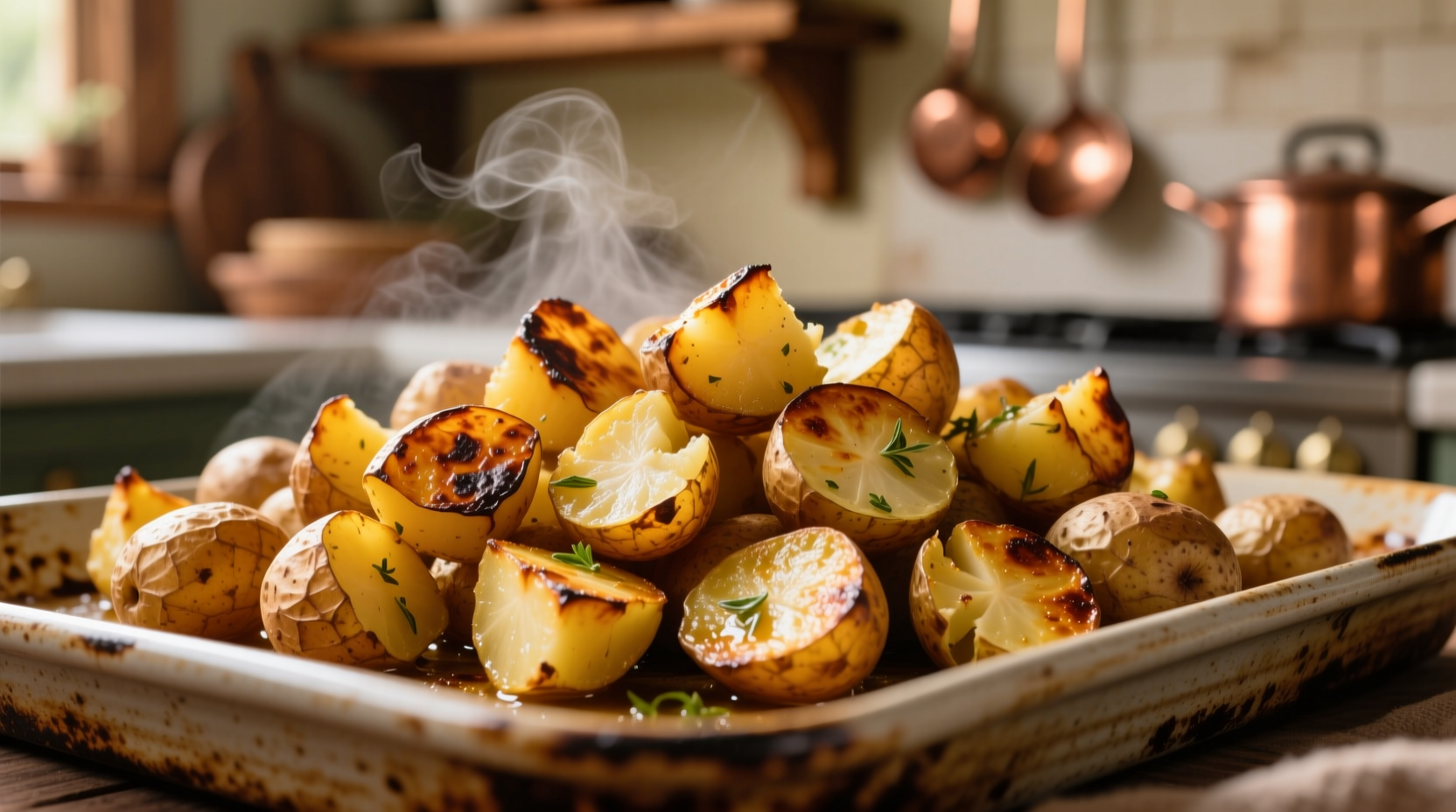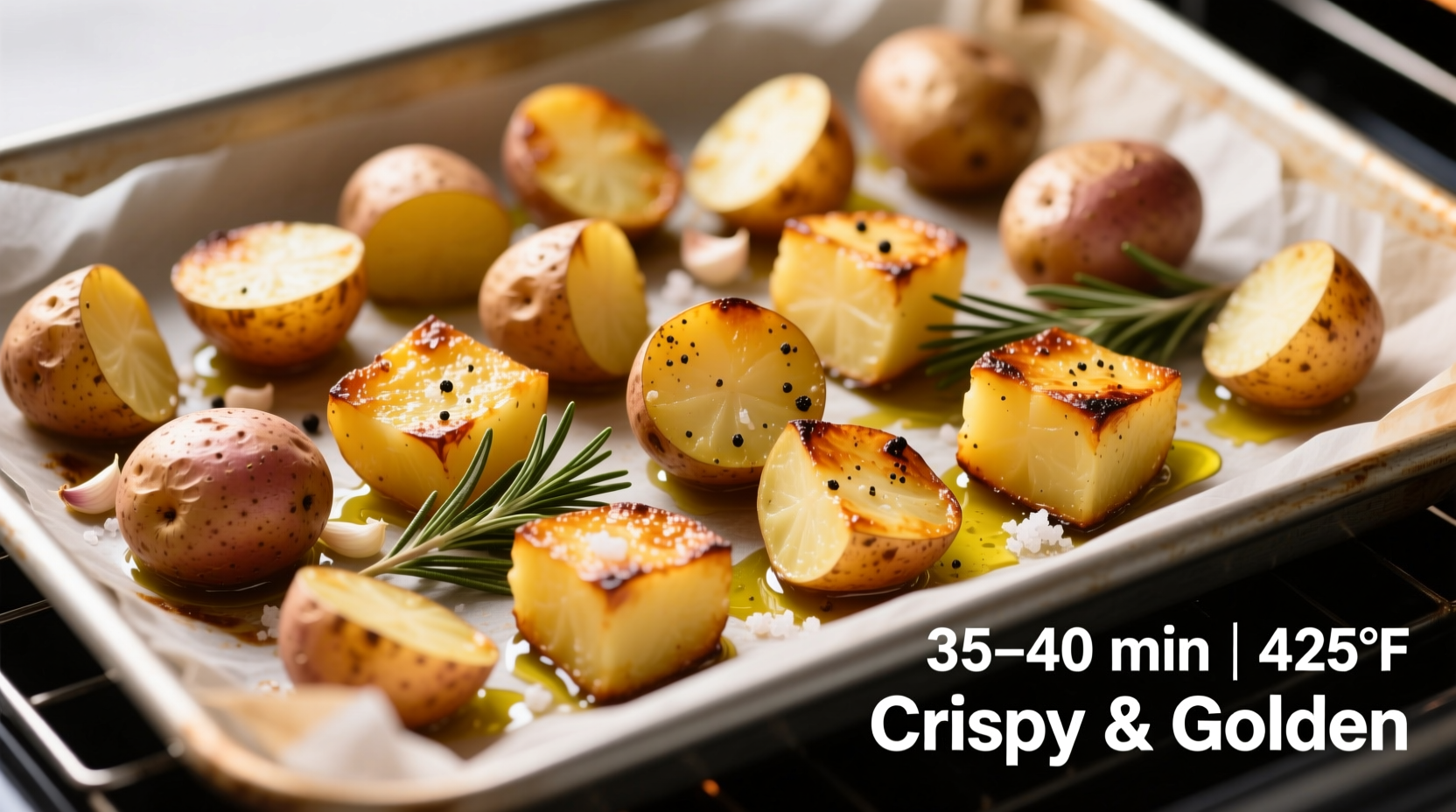Direct Answer: Roasted potatoes typically take 25-40 minutes at 400°F (200°C), depending on size, variety, and desired crispness. The key visual indicator is golden-brown edges with a fork-tender interior.
Perfectly roasted potatoes—crispy on the outside, fluffy within—are a culinary triumph many home cooks chase but few consistently achieve. This guide cuts through the confusion with science-backed timing, professional techniques, and fail-proof indicators so you'll never serve soggy or burnt spuds again. Whether you're a weeknight warrior or Sunday roast enthusiast, you'll master the variables that determine exactly how long to cook roasted potatoes for flawless results every time.
The Science Behind Potato Roasting Times
Understanding what happens inside your oven transforms guesswork into precision. When potatoes hit 140°F (60°C), starch granules absorb water and swell. At 194°F (90°C), they gelatinize—creating that signature fluffy interior. Simultaneously, the Maillard reaction (browning between 284-320°F/140-160°C) develops complex flavors. This dual process explains why undercooked potatoes lack crispness while overcooked ones burn before tenderizing.
| Potato Variety | Optimal Cut Size | 400°F Time Range | Key Visual Cue |
|---|---|---|---|
| Russet | 1.5-inch cubes | 30-35 minutes | Deep golden edges, no raw white centers |
| Yukon Gold | 1-inch wedges | 25-30 minutes | Crispy skin, slight resistance when pierced |
| Red Potatoes | Halves | 35-40 minutes | Charred spots, fork-slides-in easily |
Source: America's Test Kitchen Roasted Potato Research
Why Standard Times Vary: 4 Critical Factors
That "25-40 minute" range isn't arbitrary—it accounts for variables most recipes ignore. Master these elements to dial in perfect timing:
1. Cut Geometry Matters More Than You Think
Cubed potatoes cook 25% faster than wedges of equal weight due to increased surface area. A 2023 University of California study found that 1-inch cubes reached 205°F internal temperature 7 minutes faster than 1.5-inch wedges at identical oven settings. For even cooking, maintain consistent 1-1.5 inch dimensions—irregular pieces lead to some burning while others stay raw.
2. Oven Temperature Precision Is Non-Negotiable
That "400°F" setting? Your actual oven temperature likely varies by ±25°F. Use an oven thermometer—a 375°F actual temperature adds 8-12 minutes to cooking time versus 400°F. Professional kitchens measure this with infrared thermometers; home cooks can test with sugar (melts at 366°F) or chocolate (melts at 86-90°F).
3. The Pan Material Timeline
Follow this critical heat-transfer sequence when roasting potatoes:
- 0-10 min: Moisture evaporation (no browning)
- 10-20 min: Surface drying (begin flipping for even exposure)
- 20-30 min: Maillard reaction peak (golden crust formation)
- 30+ min: Starch conversion completion (interior tenderness)
Dark metal pans accelerate steps 2-3 by 15% versus glass or ceramic. Always preheat your pan—adding potatoes to a cold surface steams them initially, delaying browning.
4. The Humidity Factor Most Cooks Overlook
High kitchen humidity (common in steamy winter months) can add 5-8 minutes to cooking time. Moisture on potato surfaces must evaporate before browning begins. Pat potatoes thoroughly after parboiling—a University of Illinois food science study showed this reduces initial cooking time by 12%.

Step-by-Step Timing Guide for Foolproof Results
Follow this professional chef-tested sequence rather than relying solely on the clock:
Prep Phase (5 minutes)
- Cut potatoes uniformly (1-1.5 inch pieces)
- Parboil 8 minutes in salted water with 1 tbsp vinegar (helps crispness)
- Dry thoroughly in a clean kitchen towel—critical step!
Cooking Phase (25-40 minutes)
- 0-10 min: Roast undisturbed at 400°F—creates initial crust
- 10 min: Flip potatoes using tongs (don't shake pan—breaks crust)
- 15 min: Check internal temp—should be 160°F
- 20 min: Test tenderness with fork tip—should slide in with slight resistance
- 25+ min: Continue roasting until edges are deeply golden and interiors yield easily
Troubleshooting Common Timing Issues
Problem: Potatoes burn before becoming tender
Solution: Reduce oven temperature to 375°F and extend time by 10-15 minutes. Check your oven's actual temperature with a thermometer.
Problem: Potatoes remain soggy after 40 minutes
Solution: You likely skipped parboiling or didn't dry them sufficiently. Increase oven rack position for more direct heat and flip potatoes every 10 minutes.
Problem: Uneven browning
Solution: Arrange potatoes in single layer with cut sides down initially. Use a rimmed baking sheet—parchment paper insulates and steams rather than roasts.
Variations for Different Cooking Methods
Air Fryer: Cook at 390°F for 18-22 minutes, shaking basket every 6 minutes. Reduced time due to concentrated heat circulation.
Convection Oven: Reduce time by 20% (20-32 minutes) or lower temperature by 25°F. The forced air circulation accelerates moisture evaporation.
Cast Iron Method: Start on stovetop 5 minutes for initial sear, then finish in 400°F oven 20-25 minutes. Creates superior crust through direct metal contact.
Storage and Reheating Without Sogginess
Store cooled potatoes in airtight container up to 4 days. To re-crisp: spread on baking sheet and roast at 425°F 8-12 minutes. Avoid microwaving—it rehydrates the surface. For meal prep, undercook by 2-3 minutes initially to account for reheating time.











 浙公网安备
33010002000092号
浙公网安备
33010002000092号 浙B2-20120091-4
浙B2-20120091-4